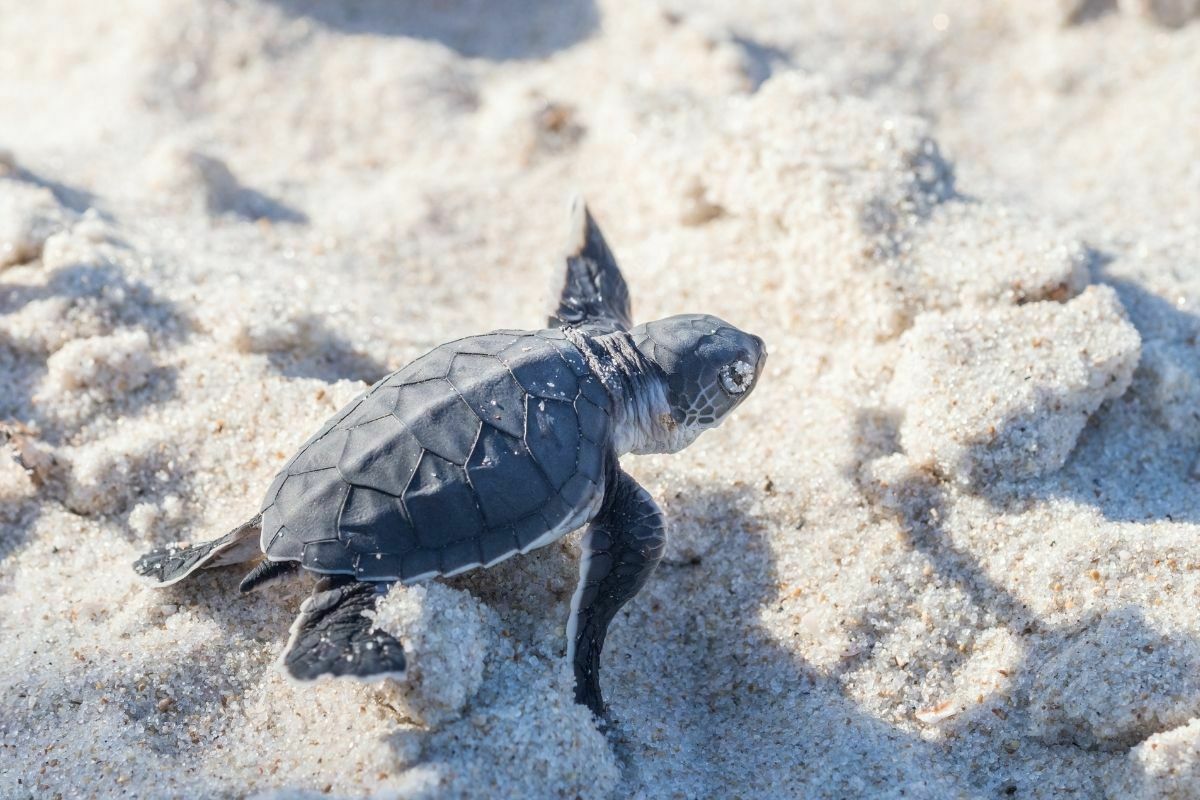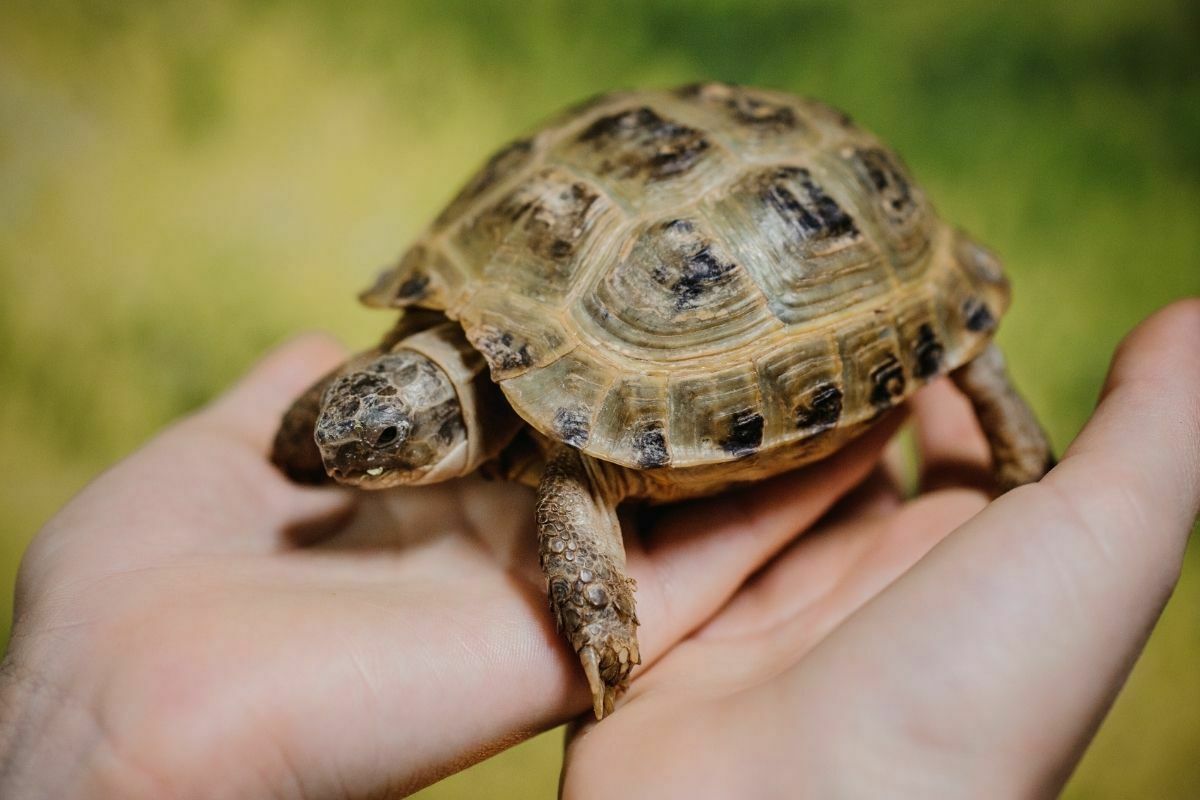Turtles often make for very good and unique pets, but they need a lot more care and attention compared to other pet animals such as a cat.
Even though they often require a bit more effort to keep them happy, turtles are becoming a more popular pet due to their small size and cute-looking faces that captivate a lot of people.

The most common pet turtles and the ones you have probably seen the most in pet shops are those with green shells, such as painted turtles, yellow-bellied turtles, Eastern River Cooters, and American Snapping turtles.
While buying a turtle is easy, sometimes people don’t realize the amount of time and effort that they will have to put into caring for and raising a baby turtle, especially if they have never owned an exotic pet before.
Baby turtle care is unique from adult turtle care, as infant turtles are more vulnerable to environmental stress and changes than adult turtles.
Using some visual clues from your new pet, you should be able to see how well they are doing and if any changes to their food or environment need to be made to keep them happy and healthy.
Here is a complete guide on how to care for these cute little animals to give them the best start in life.
Their Environment
There is a lot to get right when it comes to caring for turtles, but getting their new home looking and feeling right is probably one of the most important things you have to do. Baby turtles need a specific environment to grow and live in.
The first big mistake that people make when setting up their new turtle home is putting them into a fish tank.
Turtles should never be housed in an aquarium or fish tank as they require the ability to sometimes escape the water and have a walk around on dry land. They often use this small dry area to rest after having a good swim.
Here are a few other things that you have to keep in mind when creating your turtle habitat.
The Water
The water in your turtle home should not be too shallow or too deep, as even though they like swimming they still need to be able to get out of the water easily.
They require water that is neither too deep nor too shallow since they require a habitat that allows them to swim while simultaneously resting on land.
The most secure method of determining how deep to fill their tank is to measure the breadth of their shells. The water should be approximately an inch taller than the shell’s breadth.
This is the perfect amount of water to let the newborn turtle freely swim. Keep in mind that you must replace the water every day or, if using a filter, every three days.
Decoration
You may incorporate some pebbles and little green plants into the tank to provide a pleasant and natural environment for the young pet, even if it is kept in an artificial setting.
Your turtles may consume the water plants, depending on the species though. Therefore, if you want to use those plants just for ornamental purposes, you might end up wasting your money!
Turtles are accustomed to grazing on green vegetation in the wild. Although juvenile turtles require more protein than adults, this does not prevent them from nibbling on plants in their new home.
By creating a more natural habitat for your young turtle, you will stop your baby turtle from becoming stressed. If your turtle gets a bit too stressed because something is wrong with their home, they may stop eating, which can cause some medical issues.
Keeping The Turtle Safe
You must protect the enclosure and never allow your pet turtle to roam freely throughout your home.
It’s perilous for these little turtles to be out of the habitat that you have created, as they may consume items that should not be eaten, which can make them very sick.
Another danger if they escape is that they would become quickly disoriented and will never be able to find their way home.
Turtles Need Heat
To survive and thrive, the environment of a baby turtle needs to be at a very specific temperature. The water and basking area should be approximately 86 degrees Fahrenheit to keep the turtles warm and comfortable.
To keep these baby turtles warm, pet businesses recommend that owners light a UVB lamp or bulb and set it over the tank.
Additionally, you may place a heating pad beneath the tank, but you must continually monitor the heat and water temperature to avoid overheating the turtle home.
If a turtle gets too hot or too cold it may sadly die, so you must constantly monitor the temperature of its enclosure.
The Basking Spot
UVB rays are crucial for keeping your turtle healthy and happy, and the most effective way to guarantee that your turtles receive an appropriate amount of UVB rays is to give them an ample basking area.
UVB rays contribute to the creation of vitamin D3, which is required for calcium absorption. Without these, your turtles may have bone diseases, develop weak bones, and grow very slowly.
Basking stations can be built or purchased from a pet store. All that is required is a firm platform just outside of the water capable of supporting the weight of your baby turtle.
Add a UVB bulb or lamp above this area, and you’re good to go. Your turtle should climb out of the water and have a rest under the lamp a few times a day.
Another option is to position the turtle’s enclosure so that the basking area faces some sunlight. The rays of the sun serve the same purpose as UVB bulbs.
However, sunlight can be unpredictable, and on cloudy days your turtle will not get enough sunlight to synthesize vitamin D3.
Also if the sun is facing the tank too directly, then the area may get too hot and your turtle will overheat and get sick. Using a UVB lamp is a much more effective and foolproof method of keeping your turtle warm and happy.
Their Diet
Feed these young turtles no more than once or twice daily. Never overfeed them, since this can cause them to grow too rapidly and their shells may deform. This not only creates an ugly appearance for the poor turtles but more seriously it can be very painful to them.
Turtle food is available in the shape of pellets at pet stores, which are needed to aid them in getting the necessary nutrients to grow big and strong.
However, these little turtles should also be provided with fresh vegetables. You may leave these plants in their home and they will occasionally nibble on them.
When you offer them plants to chew on inside their pet house, you should also provide them with a little bit of pet food. Remove any leftovers and clean the area if there is any rubbish or debris to provide a secure environment for your new turtle.
Why Won’t My Turtle Eat?

Turtles are prone to becoming agitated and stressed, and the stress of relocation from the pet store or breeder to your home may lead them to lose their appetite for a few days.
However, if your turtle’s feeding patterns do not return to normal after a few days, there is cause for concern.
A lot of times, your turtle may not be eating due to issues in their environment. If there is not enough light or too much light, if the area is dirty, or if the water is not the right temperature, your turtle’s feeding cycle will be disturbed.
Additionally, turtles are cautious by nature. If you’ve placed the tank in a location with a lot of noise, your turtle is probably hesitant to come out and approach the meal.
If you are confident that the tank layout is proper, double-check the food you are providing. Turtle hatchlings require a very specialized diet. As much as possible, limit yourself to the foods listed above.
Can I Keep Two Turtles Together?
In a huge tank, one turtle may appear out of place so you might be thinking about getting a second one.
When turtles are young, raising more than two turtles at the same time is not difficult. Baby turtles consume relatively little and have dietary needs that are similar across species.
What simplifies matters even further is the fact that baby turtles cohabitate silently and get along very nicely. Another thing that contributes to this peace is the fact that, despite their small size, the turtles perceive the aquarium as a large ocean.
So long as they have sufficient space and are not obligated to socialize regularly, two turtles in one tank should get along nicely.
Summary
Turtles of many kinds require the same degree of care, so no matter what kind you get, the guide above should be helpful to you.
However, you must keep in mind that baby turtles require more care and attention than adult turtles in terms of housing, feeding, cleaning, and handling.
Keeping a turtle as a pet is a huge responsibility. Before getting your turtle, you should read up on everything you will need to know about turtle care. This will ensure that you can keep your new pet happy and healthy in their new environment.
